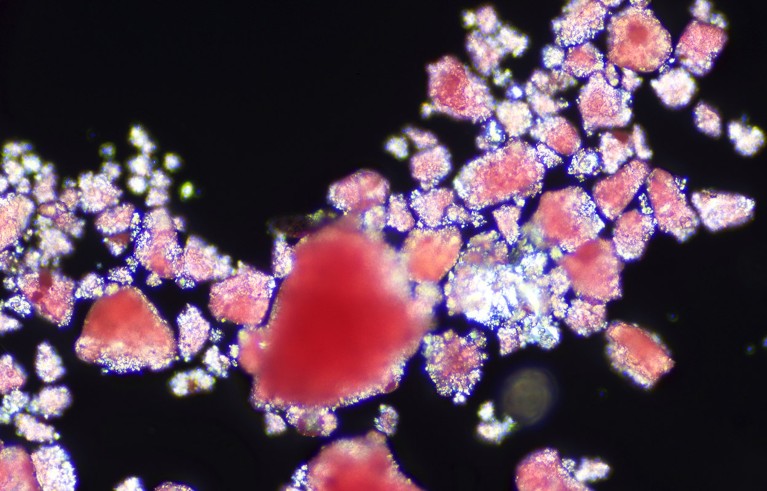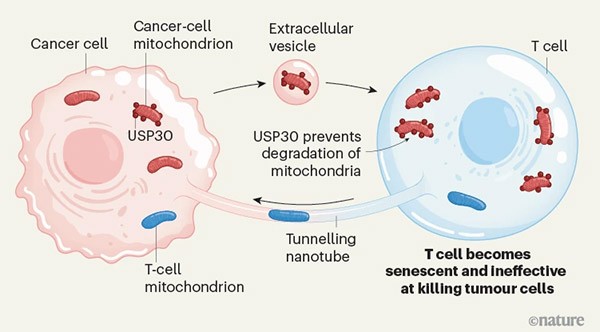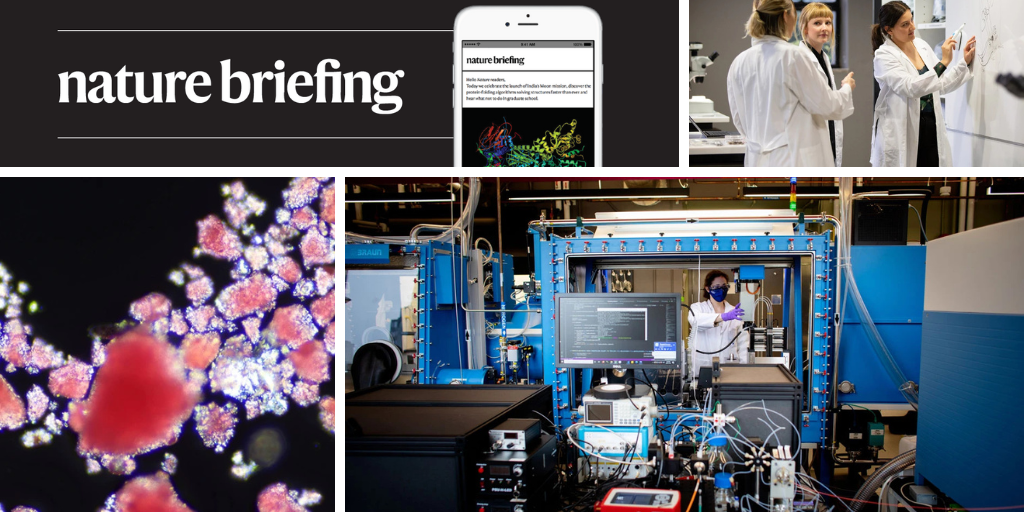Hello Nature readers, would you like to get this Briefing in your inbox free every day? Sign up here.

Tiny pieces of plastic were found lodged in blood vessels in the brains of mice.Credit: Sinclair Stammers/SPL
In mice, immune cells carry microplastics — specks of plastic less than 5 millimetres long — through the bloodstream, where they eventually become lodged in blood vessels in the brain. The plastic-packed cells appeared in the mice’s brains just hours after they were given polystyrene-laced water and piled up “like a car crash in the blood vessels”, says biomedical researcher and study author Haipeng Huang. The obstructions sometimes cleared eventually, but others stayed stuck for the entire month-long observation period and had effects including impairing the mice’s mobility. It’s not clear whether such blockages occur in people.
Reference: Science Advances paper
Using hundreds of policy documents covering 121 countries and 27 languages, researchers have identified trends in the academic-promotion criteria of nearly 250 universities and government agencies. Unsurprisingly, some 97% of the documents included research output as a criterion for promotion. However, high-income countries increasingly rely on detailed assessments of researcher quality — more so than upper-middle-income countries, in which quantitative metrics remain the gold standard. Study co-author Yensi Flores Bueso hopes this work “provides a foundation to rethink policies that foster equity, inclusivity and research integrity as fundamental pillars of our research culture”.
The current volatility in the quantum-computing share market isn’t justified by the breakthroughs and setbacks in the field, says Global Quantum Intelligence (GQI), a company that tracks the quantum market. Share prices in several quantum-computing companies crashed this month in response to unenthusiastic comments from Nvidia CEO Jensen Huang. Google announcements in 2024 had pushed them to record highs. “We feel the stock market has overreacted to all these announcements,” says computer scientist Doug Finke, who is GQI’s chief content officer. The difficulty with properly valuing quantum stocks is that no firm has mature products to sell, and no one company appears to have truly pulled ahead in the race to make a useful quantum computer.
Cancer cells can sabotage immune cells that try to attack them by filling them with defective mitochondria, the organelles that cells rely on to make energy. In samples from three people with cancer, researchers noticed that mitochondria in both the tumour cells and immune cells called tumour-infiltrating lymphocytes (TILs) shared the same mutations. When they grew cancer cells with fluorescent-tagged mitochondria alongside TILs, the TILs had taken on some faulty mitochondria after only 24 hours. By 15 days, their native mitochondria had been replaced almost entirely. Tainted TILs were less able to divide and more likely to commit cell ‘suicide’.

When a T cell (right) tries to attack a cancer cell (left), the cancer cell fights back by sending defective mitochondria in an extracellular ‘parcel’ called a vesicle, which the T cell takes in. The defective organelles are coated in a protein called USP30 that prevents the T cells from breaking them down. At the same time, the cancer cell steals healthy mitochondria from the T cell through a passage it can make between them called a tunnelling nanotube. Without healthy mitochondria, T cells can’t properly make energy and they become ineffective at killing cancer cells. (Nature News & Views | 7 min read, Nature paywall)
Features & opinion
Nature’s pick of the technologies to keep your eye on this year includes ‘self-driving’ labs that use robotics and AI algorithms to help ramp up speed and capacity, CAR-T-cell therapies — made by re-engineering a person’s own immune cells — that attack solid tumours and treat autoimmune diseases, and ‘bioremediation’ strategies that use microbes to clean up microplastics and other pollutants.
In 2016, China surpassed the United States in the number of papers published — and by 2023, it had also topped the table in retractions. China has issued hundreds of policies to strengthen research integrity, but the lack of impact “could be metaphorically likened to a tiger that persistently sharpens its claws and teeth, and yet lacks the drive to hunt”, write research-integrity scholar Shaoxiong Brian Xu and applied linguist Guangwei Hu. They propose five initiatives to strengthen China’s effort to combat the problem, including a national database of retractions and a website modelled on the PubPeer platform that allows for post-publication review.
Nature Human Behaviour | 10 min read
“No one in the long history of mathematics ever became better known for less,” said mathematician William Dunham of John Venn. But Venn’s creation — the interlocking circles known as Venn diagrams — are useful when simple and provocative when complex, argues maths writer and puzzle-maker Jack Murtagh. As the number of circles in the diagram rises, the number of regions delineated by their intersections skyrockets, leading us into a pleasant thicket of questions about geometry and symmetry.
Today, I’m taking things slow. Not quite as slow as the disc coral (Cycloseris cyclolites) however. By inflating and contracting its outer tissues, the dome-shaped coral can inch itself along the ocean floor toward a light source, scientists found. But at top speeds of around 45 millimetres per day, they’re not in a rush.
Help us inch toward a better newsletter by sending your feedback to [email protected].
Thanks for reading,
Jacob Smith, associate editor, Nature Briefing
With contributions by Flora Graham
Want more? Sign up to our other free Nature Briefing newsletters:
• Nature Briefing: Careers — insights, advice and award-winning journalism to help you optimize your working life
• Nature Briefing: Microbiology — the most abundant living entities on our planet — microorganisms — and the role they play in health, the environment and food systems
• Nature Briefing: Anthropocene — climate change, biodiversity, sustainability and geoengineering
• Nature Briefing: AI & Robotics — 100% written by humans, of course
• Nature Briefing: Cancer — a weekly newsletter written with cancer researchers in mind
• Nature Briefing: Translational Research — covers biotechnology, drug discovery and pharma


